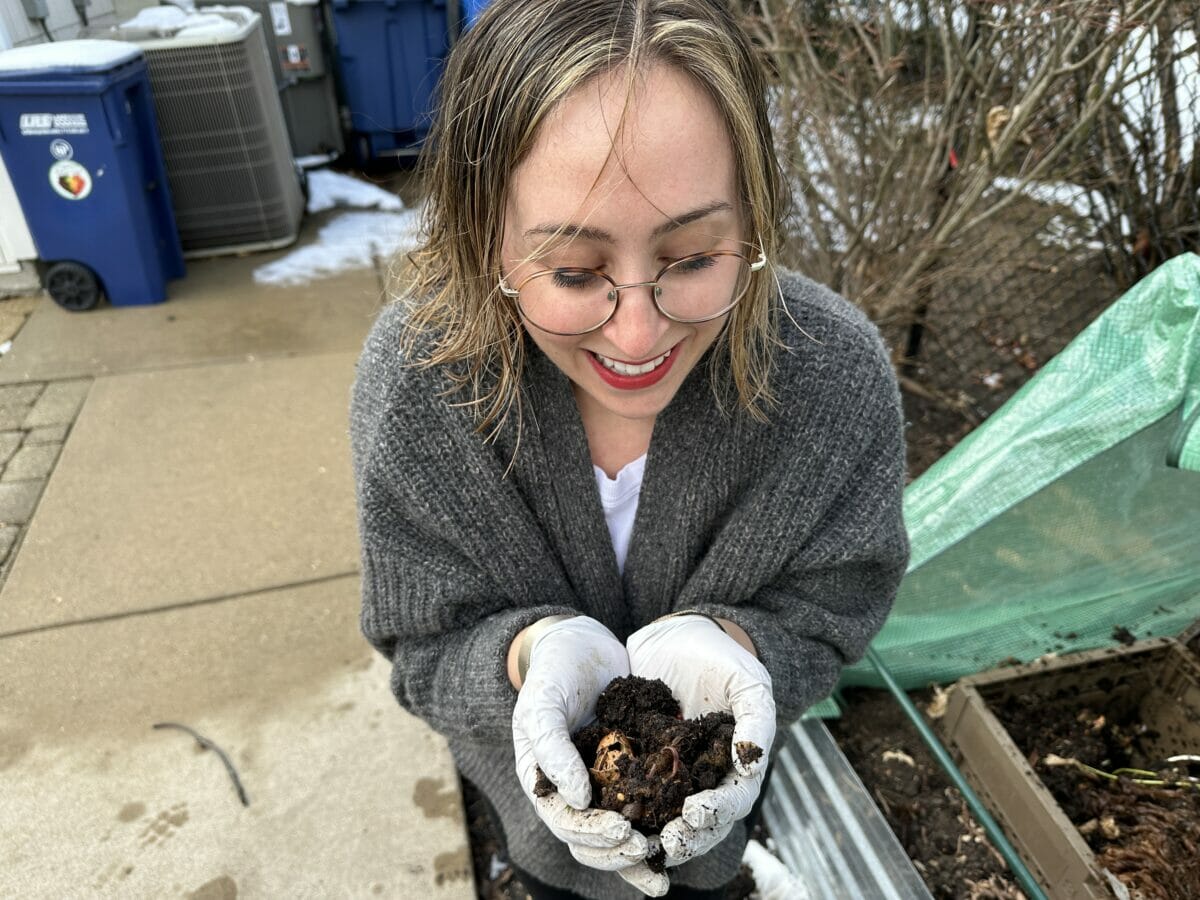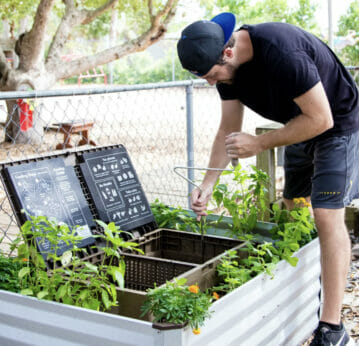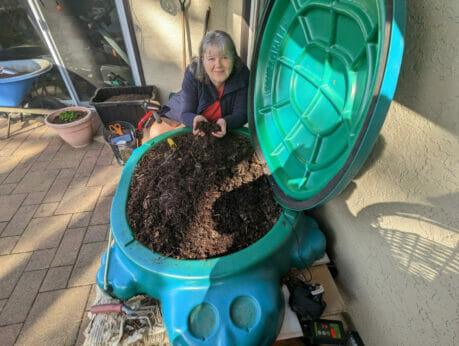How I Went from a Non-Recycler to a Vermicompost Queen
I discovered that worms may be my best chance at fighting climate change.
How I Went from a Non-Recycler to a Vermicompost Queen
I discovered that worms may be my best chance at fighting climate change.

The author with her worms.by Ariel Kanter.
Just a few years ago, I barely recycled. Living in a Hobbit-sized apartment in Brooklyn, I didn’t want to use up precious space with a recycling bin, especially because the recycling situation in my building was non-existent anyway.
So when my husband and I absconded to the suburbs of Chicago during the pandemic, I was excited to finally have space to do things right and make up for my non-recycling sins by not just recycling but composting, too. I knew that compost is good for gardening—and had grand plans for my new backyard. Why not keep my food waste from landfills and improve my garden all at the same time?
What I didn’t know was just how impactful this decision could be for the environment. “Most people don’t realize that food waste in landfills is a huge contributor to climate change,” says Rhonda Sherman, Extension Solid Waste specialist at NC State University, who literally wrote the book on vermicomposting. (In fact, 8%-10% of global greenhouse gas emissions are associated with food waste.) “When food waste is in an airless environment, it breaks down very slowly and releases methane. It actually makes landfills themselves—which are the number three human activity that is causing climate change—more toxic.”
More than 50% of municipal garbage put onto your curb—as part of the 167 million tons of trash sent to landfills each year—is actually compostable, according to the EPA. Think of what we could accomplish by actually composting some of that trash. And it’s not that difficult to get started.
If you’ve never composted before or you live in a town that doesn’t collect your food scraps, there are two main ways to do it at home. The most common is called thermophilic composting, a process by which microbes and enzymes break down food scraps into organic matter. The process produces heat, which is why you’ll often see outdoor compost piles steaming. Because of the heat production and anaerobic microbes, you can’t really have a thermophilic compost pile indoors. Then there’s vermicomposting, Rhonda Sherman’s specialty, which uses worms to digest food scraps and produce castings (essentially worm manure that makes for a nitrogen-rich soil amendment).
While both methods do create compost and keep food from landfills, the actual product is very different. A cubic yard of regular compost sells for up to $35. Vermicompost? $200 to $1,200 per cubic yard. That’s because the plant growth hormones and humic and fulvic acids in vermicompost create more growth, a higher yield and better root development. They can also help suppress diseases and pests. Plus, the microorganisms keep the smell at bay, so you can even vermicompost indoors.
What ultimately drew me to vermicomposting was discovering the Subpod, a vermicompost bin that is set inside a garden bed. Since it’s mostly underground and surrounded by soil, the worms are protected from harsh winters and direct sunlight. Plus, it has filters, which allow air to circulate through and help the aerobic (non-stinky) microbes work faster. With holes along the sides for worms to move from the bin to the bed and back again, the Subpod also promises to create not just healthy vermicompost but a healthier environment for plants and flowers inside the bed itself. As a food writer, the idea of a lush garden brimming with produce was enough motivation to pay the some $200 for the setup.

Getting everything together was simple. But I was not prepared for the “vermi” part of this compost. When the box of red wiggler worms arrived at my doorstep, I picked it up like it was a grenade without the pin and dumped the squirming worms into the bottom of the bin. I was full of fear and regret, but was determined to not have wasted the money I had invested in my bid for self-improvement.
Once the worms were settled in with their bedding (damp newspaper strips), I began adding food scraps from our countertop collection bin every week or so. Since worms breathe through their skin, they need an environment that’s about 60%-80% moisture: that’s why if I have a particularly juicy feeding, I add some sort of dried carbon, like bits of cardboard, newspaper, dried leaves or even sawdust. If you have the right balance of carbon (all this dried stuff) and nitrogen (food stuff), the worms will eat and reproduce happily. Aside from feeding, the Subpod team also recommends that you aerate the mixture to make sure the worms are getting enough oxygen.
Despite my initial squirminess with my worms, I quickly got into the flow of feeding, aerating and reaping the benefits—and discovered whole communities of other vermicomposters, too.
There’s Sandra Birrell, a PhD in Cooperative Education, who is also a volunteer accessibility garden mentor on Vancouver Island. She manages the four in-ground worm bins in her garden, two tiered stacking outdoor worm farms, an outdoor worm farm made from a converted children’s sandbox (pictured) and a temporary indoor worm bin all from her mobility scooter—and is expecting to produce about 70 gallons of worm castings this year. “Choosing the right container is important, not only in terms of what’s best for the worms but also the best for me,” she says. “Worm castings are heavy, so I make sure to use lightweight containers. Ones with built-in grips or handles are best so you can move it around with just one arm if you need to.” From there, it’s simple for her to maintain the bins, feed the worms and harvest the castings from a seated position. Her top tip? Blend your food scraps in a food processor, then keep the mixture in plastic bags in the freezer to give your worms a “mixed buffet” whenever it’s time to feed them.

For Myles Stubblefield, a veteran managing PTSD, worm farming is a cathartic experience that helps him manage stress. He’s the founder and self-described “Benevolent King of Worms” of Worm Works in Buffalo, New York, an urban worm farm and composting service that collects food scraps from nearby restaurants, residential spots and Highmark Stadium (home of the Buffalo Bills). With the scraps, he makes healthy vermicompost, then sells it online and runs workshops for locals interested in the process. It’s the silent chores that come along with composting—such as moving and aerating the thousands of pounds of compost and food scraps by hand—that make Myles jump out of bed at 4 a.m. every day without even setting an alarm. It’s a “cleansing meditation,” he says, one that quiets his brain and makes him grateful for each day.
Sandra and Myles aren’t the only ones. Rhonda tells me that tens of thousands of people around the world practice vermicomposting. In fact, people from 124 countries have reached out to her to learn how to get started. She says that you don’t even need an expensive setup like the Subpod. She even has a whole YouTube video on how to set up a simple vermicompost bin. All you need is a bin with a top, which you can buy at any Walmart, Target or hardware store. You can leave it outdoors or keep it inside. All of your steps will be the same: Add your worms and some damp worm bedding, add your food scraps and wait.

Two years since dropping the Subpod into my garden bed, my worms are going strong. Whenever I open the bin, I am astounded by what these tiny little marvels can accomplish.
I’m going away this weekend and need to feed them before I leave. I’ve got two buckets on my counter full of carrot fronds, banana peels, coffee grounds, egg shells and squash skins. It’s gotten a little icky and juicy by now, but that’s okay. The worms don’t mind.
The worms, which were once horrifying to me, are sort of like my pets now. Over the past two years, they’ve processed hundreds of buckets of food waste and truly made my garden bountiful. And they continue to create miracles: Last summer, a cantaloupe seed sprouted in the compost, I plucked it out, planted it and grew another cantaloupe. It was delicious.
Follow us
This work is licensed under a Creative Commons Attribution-NoDerivatives 4.0 International License.
Want to republish a Modern Farmer story?
We are happy for Modern Farmer stories to be shared, and encourage you to republish our articles for your audience. When doing so, we ask that you follow these guidelines:
Please credit us and our writers
For the author byline, please use “Author Name, Modern Farmer.” At the top of our stories, if on the web, please include this text and link: “This story was originally published by Modern Farmer.”
Please make sure to include a link back to either our home page or the article URL.
At the bottom of the story, please include the following text:
“Modern Farmer is a nonprofit initiative dedicated to raising awareness and catalyzing action at the intersection of food, agriculture, and society. Read more at <link>Modern Farmer</link>.”
Use our widget
We’d like to be able to track our stories, so we ask that if you republish our content, you do so using our widget (located on the left hand side of the article). The HTML code has a built-in tracker that tells us the data and domain where the story was published, as well as view counts.
Check the image requirements
It’s your responsibility to confirm you're licensed to republish images in our articles. Some images, such as those from commercial providers, don't allow their images to be republished without permission or payment. Copyright terms are generally listed in the image caption and attribution. You are welcome to omit our images or substitute with your own. Charts and interactive graphics follow the same rules.
Don’t change too much. Or, ask us first.
Articles must be republished in their entirety. It’s okay to change references to time (“today” to “yesterday”) or location (“Iowa City, IA” to “here”). But please keep everything else the same.
If you feel strongly that a more material edit needs to be made, get in touch with us at [email protected]. We’re happy to discuss it with the original author, but we must have prior approval for changes before publication.
Special cases
Extracts. You may run the first few lines or paragraphs of the article and then say: “Read the full article at Modern Farmer” with a link back to the original article.
Quotes. You may quote authors provided you include a link back to the article URL.
Translations. These require writer approval. To inquire about translation of a Modern Farmer article, contact us at [email protected]
Signed consent / copyright release forms. These are not required, provided you are following these guidelines.
Print. Articles can be republished in print under these same rules, with the exception that you do not need to include the links.
Tag us
When sharing the story on social media, please tag us using the following: - Twitter (@ModFarm) - Facebook (@ModernFarmerMedia) - Instagram (@modfarm)
Use our content respectfully
Modern Farmer is a nonprofit and as such we share our content for free and in good faith in order to reach new audiences. Respectfully,
No selling ads against our stories. It’s okay to put our stories on pages with ads.
Don’t republish our material wholesale, or automatically; you need to select stories to be republished individually.
You have no rights to sell, license, syndicate, or otherwise represent yourself as the authorized owner of our material to any third parties. This means that you cannot actively publish or submit our work for syndication to third party platforms or apps like Apple News or Google News. We understand that publishers cannot fully control when certain third parties automatically summarize or crawl content from publishers’ own sites.
Keep in touch
We want to hear from you if you love Modern Farmer content, have a collaboration idea, or anything else to share. As a nonprofit outlet, we work in service of our community and are always open to comments, feedback, and ideas. Contact us at [email protected].by Ariel Kanter, Modern Farmer
April 6, 2023
Modern Farmer Weekly
Solutions Hub
Innovations, ideas and inspiration. Actionable solutions for a resilient food system.
ExploreShare With Us
We want to hear from Modern Farmer readers who have thoughtful commentary, actionable solutions, or helpful ideas to share.
SubmitNecessary cookies are absolutely essential for the website to function properly. This category only includes cookies that ensures basic functionalities and security features of the website. These cookies do not store any personal information.
Any cookies that may not be particularly necessary for the website to function and are used specifically to collect user personal data via analytics, ads, other embedded contents are termed as non-necessary cookies.
Thank you for the opportunity to talk about my worms, Ariel! I should mention that my garden has never been healthier and, with each year, it keeps getting better. You inspired me to do a YouTube video on wheelchair worm farming (@NanasWorms). As a lifelong gardener, worm farming gives me the opportunity to contribute to my garden in a way I never imagined and one that gives the most benefit of anything I’ve ever done.
~ Sandra
Very well written and informative. I intend to try composting, see what happens see how far I can get . Rick. l.